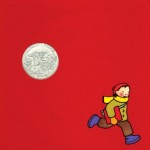(Ages 3-6)
Children’s authors are advised to leave open questions in the text, so that part of the narrative can be conveyed through the pictures. In The Red Book, illustrator, Barbara Lehman, goes one better, by dispensing with words altogether and telling an entire story through pictures.
When I spotted The Red Book in a shop a few years back, I was instantly drawn (pardon the pun) to the striking jacket design, just as the young heroine of the story is drawn (ouch!) to a glinting red volume half buried in a snow bank on a busy urban street. She opens the book to discover a sequence of illustrations depicting a solitary boy walking along a tropical beach towards . . . a red book, half buried in the sand.
The complex plot that follows is communicated seamlessly, and Lehman uses ingenious devices to layer two intersecting through lines—the story of the children, and the story of the book itself. When the girl sets off to find her friend, borne aloft by an oversized bunch of helium balloons, she accidentally drops her red book on the pavement. The childrens’ reunion unfolds across the pages of the discarded tome, ruffled by the wind. Just as the children greet one another, a gust blows the book shut. A solitary cyclist retrieves the closed book from the pavement and tucks it under his arm—inviting readers to invent a sequel.
Barbara Lehman has illustrated several wordless picture books in which gentle, inquisitive protagonists are transported across space and time by means of a box of memorabilia, a train, or a painting. Her colouring-book style graphics and bold, geometric forms contribute to a strongly marked style. What distinguishes The Red Book from her other engrossingly whimsical works is the protagonists’ sense of yearning. Their initial loneliness is palpable. Without friendship, the girl’s bustling city and the boy’s sun-drenched beach are equally desolate. Furthermore, as Lehman’s most complex story, The Red Book lends itself to numerous different retellings, from the point of view of various characters.
This book, which celebrates human connection, invites sharing and discussion precisely because we must supply the missing words. I sometimes draft mental shopping lists while re-reading bedtime favourites, but The Red Book challenges me to engage, ask my children questions about the pictures, and find new approaches. (First person narration? Shall we role-play the different characters? What about an ad lib rap?) It’s not just a story—it’s a workout.
Maybe its versatility explains why The Red Book has enjoyed a particularly long shelf life in our family. We shared it with our son for years, and now he interprets it for his toddler sister. Master Alistair’s version includes the telling line, “Math class was so boring that the girl said, ‘I think I’ll look at my new book. The teacher won’t catch me if I pretend that I’m writing numbers.’” When you open The Red Book, you never know what you may discover.


No comments yet.